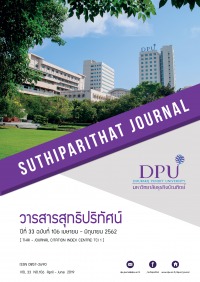ปัจจัยที่มีอิทธิพลต่อความสมดุลระหว่างงานและชีวิตของเจ้าหน้าที่ดูแลลูกค้าทางโทรศัพท์หญิง กลุ่มธุรกิจเทคโนโลยีสารสนเทศและการสื่อสาร
คำสำคัญ:
การทำงานล่วงเวลา, อายุงาน, ความฉลาดทางอารมณ์, สมดุลระหว่างงานและชีวิต, การปฏิบัติงาน, เจ้าหน้าที่ดูแลลูกค้าทางโทรศัพท์บทคัดย่อ
การวิจัยนี้มีวัตถุประสงค์เพื่อศึกษาอิทธิพลของปัจจัยด้านครอบครัว ปัจจัยด้านงาน ความฉลาดทางอารมณ์ และการปฏิบัติงานที่มีต่อสมดุลระหว่างงานและชีวิตของเจ้าหน้าที่ดูแลลูกค้าทางโทรศัพท์หญิง กลุ่มธุรกิจเทคโนโลยีสารสนเทศและการสื่อสาร เก็บรวบรวมข้อมูลด้วยวิธีผสม โดยวิธีเชิงปริมาณใช้แบบสอบถามในการเก็บข้อมูลจากเจ้าหน้าที่ดูแลลูกค้าทางโทรศัพท์หญิง จำนวน 484 คน สถิติที่ใช้ในการวิเคราะห์ข้อมูล ได้แก่ ค่าร้อยละ ค่าเฉลี่ย ส่วนเบี่ยงเบนมาตรฐาน และการวิเคราะห์ถดถอยพหุแบบขั้นตอน วิธีเชิงคุณภาพเก็บรวบรวมข้อมูลโดยใช้แบบสอบถามปลายเปิด วิธีการสนทนากลุ่ม และการสัมภาษณ์เชิงลึกกับเจ้าหน้าที่ดูแลลูกค้าทางโทรศัพท์หญิง จำนวน 12 คน และวิเคราะห์ข้อมูลด้วยวิธีวิเคราะห์เนื้อหา ผลการวิจัยพบว่า การทำงานล่วงเวลา อายุงาน ความฉลาดทางอารมณ์ การปฏิบัติงานสามารถร่วมกันพยากรณ์สมดุลระหว่างงานและชีวิตของเจ้าหน้าที่ดูแลลูกค้าทางโทรศัพท์ได้ร้อยละ 42.1 อย่างมีนัยสำคัญทางสถิติที่ระดับ .001 และยังพบว่าข้อมูลเชิงคุณภาพนั้นสนับสนุนผลการวิจัยเชิงปริมาณ
เอกสารอ้างอิง
ขนิญร์นัสท์ อินทุลักษณ์, และอารีย์วรรณ อ่วมตานี. (2557). การสร้างสมดุลชีวิตกับงานของพยาบาลวิชาชีพ โรงพยาบาลเอกชนแห่งหนึ่ง. วารสารพยาบาลทหารบก, 15(3), 382-389.
นิศาชล โทแก้ว, สุธนา บุญเหลือ, และภูริศร์ พงษ์เพียจันทร์. (2557). ความสัมพันธ์ระหว่างความสมดุลชีวิตในการทำงานกับผลการปฏิบัติงานของผู้จัดการแผนกต้อนรับส่วนหน้าธุรกิจโรงแรมในภาคตะวันออกเฉียงเหนือ. วารสารมนุษยศาสตร์และสังคมศาสตร์ มหาวิทยาลัยมหาสารคาม, 33(2), 163-172.
วาโร เพ็งสวัสดิ์. (2553). สถิติประยุกต์สำหรับการวิจัยทางสังคมศาสตร์. กรุงเทพฯ: สุวีริยาสาส์น.
ศิรภัสสร วงศ์ทองดี. (2552). การสร้างสมดุลระหว่างชีวิตกับการทำงาน. กรุงเทพฯ: สถาบันดำรงราชานุภาพ สำนักงานปลัดกระทรวงมหาดไทย.
Albertsen, K., Rafnsdottir, G., Grimsmo, A., Tomasson, K., & Kauppinen, K. (2008). Work hours and work-life balance. Scandinavian Journal of Work, Environment and Health, 5, 14-21.
Barber, L. K., Grawitch, M. J., & Maloney, P. W. (2016). Work-life balance: Contemporary perspectives. In Grawitch, M. J., & Ballard, D. W. (eds.). The psychologically healthy workplace: Building a win-win environment for organizations and employees (pp. 111-133). Washington, DC: American Psychological Association.
Barik, P. (2017). Work-life balance of married female teachers in government and private schools of Raipur, Chhattisgarh. IOSR Journal of Humanities and Social Science, 22(11), 38-46.
Bhandari, B., & Soni, P. H. (2015). Impact of gender, age and work experience on satisfaction towards work life balance (with special reference to Bank of Baroda, Udaipur). IOSR Journal of Business and Management, 17(3), 48-53.
Bloom, N., Kretschmer, T., & Reenen, J. V. (2006). Work-life balance, management practices and productivity. Discussion Paper, Centre for Economic Performance, London School of Economics, London.
Brough, P., Timms, C., O’Driscoll, M. P., Kalliath, T., Siu, O., Sit, C., & Lo, D. (2014). Work–life balance: A longitudinal evaluation of a new measure across Australia and New Zealand workers. The International Journal of Human Resource Management, 25(19), 2724-2744.
Butler, D. L. (2004). Bottom-line call center management creating a culture of accountability and excellent customer service. Oxford: Elsevier Butterworth-Heinemann.
Duxbury, L., & Higgins, C. (2001). Work-life balance in the new millennium: Where are we? Where do we need to go? CPRN Discussion Paper, no. 1/12 (Ottawa, ON: Canadian Policy Research Networks, October 2001), website: https://www.cprn.org.
Fagan, C., Lyonette, C., Smith, M., & Saldaña-Tejeda, A. (2012). The influence of working time arrangements on work-life integration or “balance”: A review of the international evidence. Geneva: International Labour Office.
Forsyth, S., & Polzer-Debruyne, A. (2007). The organizational pay-offs for perceived work–life balance support. Asia Pacific Journal of Human Resources, 45(1), 113-123.
Greenhaus, J. H., Collins, K. M., & Shaw, J.D. (2003). The relation between work-family balance and quality of life. Journal of Vocational Behavior, 63, 510-531.
Hill, E. J., Hawkins, A. J., Ferris, M., & Weitzman, M. (2004). Finding an extra day a week: The positive influence of perceived job flexibility on work and family life balance. Family Relations, 50, 49-58.
Hudson. (2005). The case for work life balance: Closing the gap between policy and practice, 20:20 Series. Hudson Global Resources.
Jex, S. M., & Britt, T. W. (2008). Organizational psychology (2nd ed). New Jersey: John Wiley & Sons.
Kaiser, S., Ringlstetter, M. J., Eikhof, D. R., & Cunha, M. P. (eds.). (2011). Creating balance?: International perspectives on the work-life integration of professionals. Heidelberg: Springer.
Kshirsagar, V. S., & Kadam, A. S. (2012). Impact of shift timings and income on work life balance of employees in shipping organization. International Journal of Science and Research (IJSR) IJSR (Online). 2319-7064.
Lunenburg, F. C. (2011). Emotional intelligence in the workplace: Application to leadership. International Journal of Management, Business, and Administration, 14(1), 1-6.
Mattessich, S., Shea, K., & Whitaker-Worth, D. (2017). Parenting and female dermatologists’ perceptions of work-life balance. International Journal of Women's Dermatology, 3, 127-130.
Mayer, J. D., Salovey, P., & Caruso, D. R. (2004). Emotional intelligence: Theory, findings, and implications. Psychological Inquiry, 15(3), 197-215.
Panisoara, G., & Serban, M. (2013). Marital status and work-life balance. Procedia - Social and Behavioral Sciences, 78, 21-25.
Quick, J. C., & Tetrick, L. E. (2011). Handbook of occupational health psychology (2nd ed). Washington, D.C.: American Psychological Association.
Shagvaliyeva, S., & Yazdanifard, R. (2014). Impact of flexible working hours on work-life balance. American Journal of Industrial and Business Management, 4, 20-23.
Sharma, L. N. (2014). Emotional intelligence as correlate to work life balance (A case study of Sidhi MP). Global Journal of Finance and Management, 6(6), 551-556.
Singh, S. (2004). Development of a measure of emotional intelligence. National Academy of Psychology, 49(2-3), 136-141.
Sturges, J., & Guest, D. (2004). Working to live or living to work? work/life balance early in the career. Human Resource Management Journal, 14(4), 5-20.
Thomson, P. (2008). The business benefits of flexible working. Strategic HR Review, 7(2), 17-22.
ดาวน์โหลด
เผยแพร่แล้ว
รูปแบบการอ้างอิง
ฉบับ
ประเภทบทความ
สัญญาอนุญาต
เนื้อหาและข้อมูลในบทความที่ลงตีพิมพ์ในวารสารสุทธิปริทัศน์ ถือเป็นข้อคิดเห็นและความรับผิดชอบของผู้เขียนบทความโดยตรงซึ่งกองบรรณาธิการวารสาร ไม่จำเป็นต้องเห็นด้วย หรือร่วมรับผิดชอบใด ๆ
บทความ ข้อมูล เนื้อหา รูปภาพ ฯลฯ ที่ได้รับการตีพิมพ์ในวารสารสุทธิปริทัศน์ ถือเป็นลิขสิทธิ์ของวารสารสุทธิปริทัศน์หากบุคคลหรือหน่วยงานใดต้องการนำทั้งหมดหรือส่วนหนึ่งส่วนใดไปเผยแพร่ต่อหรือเพื่อกระทำการใด ๆ จะต้องได้รับอนุญาตเป็นลายลักษณ์อักษรจากวารสารสุทธิปริทัศน์ก่อนเท่านั้น







